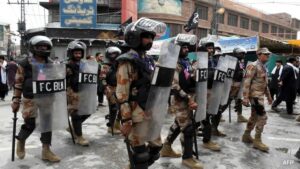Table of Contents
Swiss Peace Process
Context: In a recent interview Ukraine’s Ambassador to India stated that after the recent visit of PM Modi to Ukraine they are hopeful of India’s active participation in the second meeting of the Swiss Peace Process.
About Swiss Peace Process
- It is a global conference focused on addressing and resolving the ongoing conflict between Russia and Ukraine.
- Venue: Burgenstock resort in Switzerland.
- Participants: Around 100 delegates from various Countries and Organisations participated in the summit.
- Joint Communique: 80 countries and 4 organisations supported the final joint communique.
- Major Countries who did not sign: India, Saudi Arabia, South Africa, Thailand, Indonesia, Mexico and UAE
| UPSC PYQ |
Q. Consider the following countries: (2023)
How many of the above-mentioned countries share a land border with Ukraine? (a) Only two (b) Only three (c) Only four (d) Only five Answer: A Bordering Countries Of UKRAINE: Belarus, Russia, Moldova and Romania, Hungary, Slovakia and Poland.
|
Military Exercises
Context: In the past few months India’s Military Diplomacy is at a hectic pace. It has conducted various exercises comprising all 3 forces with countries worldwide.
About Ongoing Military Exercises of India
- Yudh Abhyas (20th Edition)
- Participating Countries: India & USA
- Venue: Mahajan Fields, Bikaner (Rajasthan)
- Significance: This year’s exercise features one of the largest U.S. contingents with around 600 personnel.
- Mitra Shakti
- Participating countries: India & Srilanka
- Venue: Maduru Oya, Sri Lanka
- Significance: This exercise is in line with India’s “Neighbourhood First” policy and its vision of “Security and Growth for all in the Region (SAGAR)”
- Tarang Shakti- 2024
- Participating Countries: (10) including US, UK, Australia, France, Germany, Japan, Singapore, and UAE.
- Venue: Jodhpur, Rajasthan
- Significance: It is the First-ever multinational air exercise of India Hosted by Indian Air force.
| Other Exercises |
|
Standing Committee on Statistics (SCoS)
Context: Recently the Union Ministry of Statistics and Programme Implementation has dissolved the Standing Committee on Statistics (SCoS).
About ScoS/ Pronab Sen Committee
- Nodal Ministry: Ministry of Statistics and Programme Implementation (MoSPI)
- Formed in: July 2023
- Composition: Chairman + 14 Members
- Chairman: Pronab Sen (India’s first Chief Statistician)
- Mandate: To advise the Union government on survey methodology including;
- How to create sampling frames
- Design sampling strategies and develop survey tools
- Finalise the plan for organising and presenting survey data.
- Reason of Dissolution:
- Overlapping of work with the recently formed Steering Committee for National Sample Surveys.
Steering Committee for National Sample Surveys
- Chairman: Rajeeva Laxman Karandikar
- Mandate:
- Review the current framework of NSS
- Address issues related to NSS methodology, sampling design, and survey instruments
- Make recommendations to the National Statistical Council (NSC)
How Arctic Sea Ice Changes affects Indian Monsoon
Context: Recently a report was published by National Centre for Polar and Ocean Research (NCPOR) and South Korea’s Korea Polar Research Institute which revealed how seasonal variations in Arctic sea ice impact the Indian summer monsoon rainfall (ISMR).
Key Findings of the Study
- Central Arctic Sea Ice Impact:
- Reduced sea ice in the central Arctic leads to less rainfall over western and peninsular India but increases rainfall in central and northern regions.
- Barents-Kara Sea Region Impact:
- Low sea ice in the Barents-Kara Sea region delays the monsoon’s onset and makes it more unpredictable, impacting rainfall patterns.
Mechanism of the Indian Summer Monsoon Rainfall (ISMR)
- Timing and Duration: The Indian summer monsoon occurs from July to September, with peak rainfall in July and August. It is one of the most significant monsoon systems globally.
- Land and Ocean Heating:
- During summer, the Indian subcontinent and Central Asia heat up faster than the surrounding oceans.
- This creates a low-pressure zone at the Tropic of Cancer, known as the Intertropical Convergence Zone (ITCZ).
- Trade Winds:
- Trade winds from the southeast move towards the Indian subcontinent. After crossing the equator, the Coriolis force deflects these winds.
- As they blow over the Arabian Sea, the winds pick up moisture and deposit that as rain over India.
- Southwest Monsoon Split: The southwest monsoon splits into two branches:
- Arabian Sea Arm: This branch brings rain to India’s west coast.
- Bay of Bengal Arm: This branch brings rain to the eastern and northeastern parts of India.
- Both arms meet over Punjab and Himachal Pradesh, where they merge as they move inland.
- Influence of other factors:
- Ocean Temperatures: Recent studies have revealed that surface temperatures in the Indian, Atlantic, and Pacific Oceans impact the ISMR.
- Circum-Global Teleconnection (CGT): It is a large atmospheric wave that flows around the globe at mid-latitudes. It impacts weather patterns by influencing the position and intensity of the monsoon.



 Operation Baam: Baloch Separatist Group ...
Operation Baam: Baloch Separatist Group ...
 National Register of Indian Citizens (NR...
National Register of Indian Citizens (NR...
 World Population Day 2025, Themes, Histo...
World Population Day 2025, Themes, Histo...





















